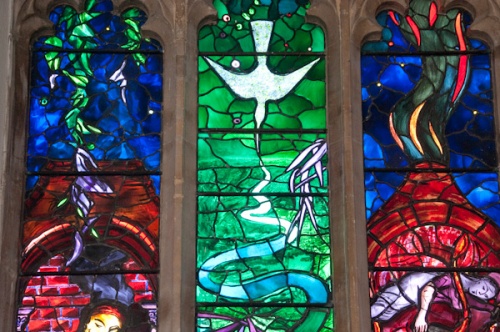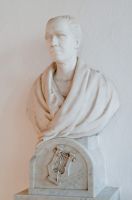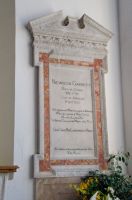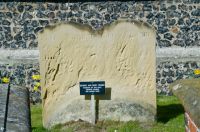
As mentioned, the tower is the oldest part of the church, and it is such a notable local landmark hat it was used for many years by mariners to pilot their ships.
Internally, the oldest feature of the church is the font, which dates to around 1320. You can see that several of the carved panels have been defaced; this destruction took place in 1643 when a local man named Thomas Johnson aided the famed iconoclast William Dowsing in destroying '20 cherubim and 38 pictures' as well as taking a sword to the carvings on the font.
Johnson is buried in the floor before the altar - a strange honour perhaps, for a man who destroyed much historic architecture at Aldeburgh, but such was life during the Reformation!
Before Johnson and Dowsing were active, the church was the scene of a much happier event. In 1573 a troupe of travelling actors gave a performance here. The troupe was known as the Earl of Leicester's Men, and they would later count among their number a certain young actor and playwright called William Shakespeare.

Other famous names associated with the church include the poet George Crabbe, a native of Aldeburgh. Crabbe (1754-1832) wrote the poem 'The Borough', which later served as the inspiration for Benjamin Britten's opera Peter Grimes. Crabbe served as curate at St Peter and St Paul's, as is commemorated by a fine bust near the organ.
Britten himself lived at Aldeburgh for many years and is commemorated in a striking memorial window. His grave is in the churchyard, as is that of Peter Pears, who, with Britten, founded the Aldeburgh Festival for which the town is famous. Also in the churchyard is the grave of Imogen Holst, daughter of composer Gustav Holst.
Another tragic memorial in the churchyard is to the men of the lifeboat Aldeburgh. On 7 December 1899, the lifeboat crew answered a distress signal from a ship offshore. Their lifeboat was capsized and seven of the men drowned. They are poignantly remembered with simple white crosses at the foot of a large stone monument.
Back within the church is a copy of an original King James I 'Black Letter Bible', and several interesting memorial brasses, plus a very well-preserved oaken parish chest, a church key dated prior to 1638, and a beautifully carved wineglass pulpit.












 We've 'tagged' this attraction information to help you find related historic attractions and learn more about major time periods mentioned.
We've 'tagged' this attraction information to help you find related historic attractions and learn more about major time periods mentioned.



